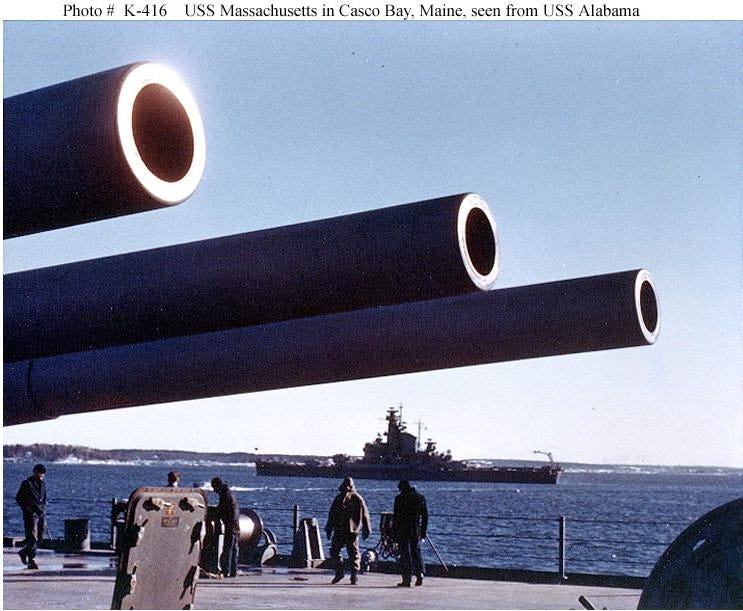Fullbore Friday
close the frenemy
This will be Part 1 of a two part series of FbF about Operation Torch I’ve pulled from the archives over a decade and a half ago.
You really need a large, blank white-board to follow this little known battle during Operation TORCH. How does this make your Sailor-blood flow?
Directly after launching their planes, Massachusetts, Wichita and Tuscaloosa unfurled battle ensigns (oversize US flags), and increased battle formation speed to 25 knots. Massachusetts led the column, followed by the cruisers at 1000-yard distances. Four destroyers screened at 3000 yards ahead of the battleship. The fifteen mile track of these ships roughly matched and paralleled the northeast to southwest line between Fedala and Casablanca Author Morison's account in Volume II, Operations in North African Waters is detailed:
"At 0640, when the formation had reached a position bearing about west northwest from Casablanca, distant 18,000 yards from Batterie El Hank and 20,000 yards from battleship Jean Bart's berth in the harbor, it began an easterly run, holding the same range. Ten minutes later, one of the flagship's spotting planes reported two submarines standing out of Casablanca Harbor, and at 0651 radioed: `There's an anti-aircraft battery opening up on me from the beach. One burst came within twelve feet. Batter up!' Another spotting plane encountered `bandits' at 0652 and signaled, `Am coming in on starboard bow with couple hostile aircraft on my tail. Pick `em off - I am the one in front!' The big ships opened up on these planes with their 5" batteries at 0701, and shot one down. The other retired; and almost simultaneously battleship Jean Bart and El Hank commenced firing. The coast defense guns straddled Massachusetts with their first salvo, and five or six splashes from Jean Bart fell about 600 yards ahead of her starboard bow. Admiral Giffen (directly in charge of this group) lost no time in giving his group the `Play Ball'. Massachusetts let go her first 16-inch salvo at 0704."
Here is just a snip - you need to read it all.
Leaving Massachusetts to count what shells remained in her magazines (60% depleted), Tuscaloosa, now leading Wichita, and destroyer Rhind, closed the French to 14,000 yards, Brooklyn and Augusta were still pursuing from the east. Primaguet was holed five times below the waterline from Augusta and Brooklyn, and had an 8" shell on her #3 turret. She retired about 11 a.m. and anchored off shore. Milan had taken five hits, mostly 8" shells. Milan retired and anchored. Brestois was hit by Augusta and this destroyer made her harbor, but after strafing from Ranger's planes, later sank. The three French warships outside the harbor still underway were destroyer leader Albatros, and destroyers Frondeur and L'Alcyon. These ships organized for one more torpedo foray at 1115. Tuscaloosa and Wichita reduced their effort to zig zags behind a smoke screen. Under continuous fire from El Hank, Wichita was hit about 1130 with light damage and 14 men wounded. Wichita then was missed by a three torpedo spread from a French submarine. Tuscaloosa and Wichita hit Frondeur. Down by the stern she made it back into port only to succumb to aircraft strafing. Shells hit Albatros twice at 1130 and she fought on with three guns, zigzagging in the smoke. One of Ranger's dive bombers scored with two bombs which penetrated a fire room and an engineroom. A hit from Augusta took out the other engineroom. Albatros lost all way. Only L'Alcyon got back in unscathed.
One battle - one that could make a dozen FbF…but we’ll stick to this week and next…maybe more. We’ll see.



Fbf never disappoints! Another great post. Will reread Morrison.
Hmmm imagine fighting admirals on the bridge of a fighting US Navy ship of war….hello 3-4 star Admirals, please read the FBF post today. You might learn something or maybe get your blue water spirit back…